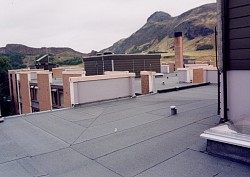 |
|
 |
|||||
|
|||||||
 |
|
 |
|||||
|
|||||||
|
BUILT-UP FELT ROOFING |
|
Domestic and Commercial Properties |
|
The concept of covering flat roofs with layers of "felt"
laid in hot
bitumen as a less-expensive |
 |
|
Pollock Halls of Residence, University of Edinburgh |
|
|
In an attempt to regulate the use of felt roofing, the British Standards Institution (BSI) investigated the various felts available and introduced British Standard 747 (BS747) as the industry standard. The felt types accepted as suitable were classed according to the bitumen carrier (felt) used:
|
|
| As a direct result of the problems with traditional felts,
manufacturers invested in serious research to come up
with
alternatives which would counter the lack confidence held by the public at large. In the 1980s the BSI considered the use of Polyester based felts and approved their use as BS 747: Type 5: Polyester Based roofing felt. In addition to the 'roll and pour' felts mentioned, great strides
were made in advancing torch-on felts. Torch-on felts can
be laid by applying Nowadays, the quality of felts to waterproof roofs is such that many
manufacturers now regularly issue 10, 15
and 20-year insurance McKenzie and Flynn Ltd are proud to be Approved Contractors for the following felt manufacturers:
|
|
| While replacing felt roof coverings it is a simple operation to
include insulation within the felt layers. The
thickness of
felt required and the insulation used is dependent on many factors. McKenzie and Flynn Ltd are happy to advise and assist their clients on the most appropriate materials for the roof being refurbished, the following being routinely used during felting operations:
|
|
| The above insulants can be mixed to achieve composite boards dependant
on the particular requirements of
the client
or his site. In addition, where existing roofs have particular problems with rainwater drainage or ponding, these can be overcome by using insulation boards specially cut to achieve falls and crossfalls. |
|